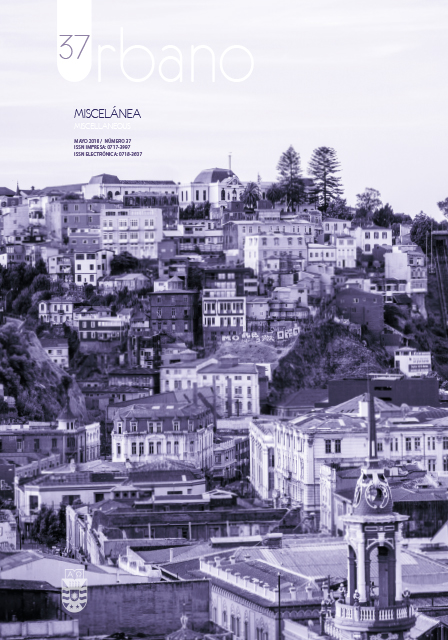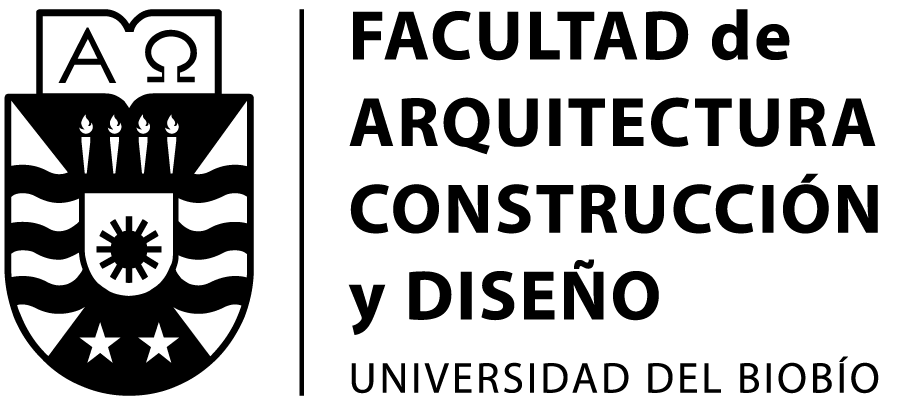The incidence of urban squares on the thermal behavior of the environment in areas of high building density. The case of the city of Mendoza, Argentina
DOI:
https://doi.org/10.22320/07183607.2018.21.37.08Keywords:
urban square, design, building density, thermal behaviorAbstract
Squares conceived of as “garden squares” - the dominant model in the cities of Latin America - generate microclimatic effects at the urban and building scales given that they act as a source of night cooling. In low- and medium-density contexts, this effect is fundamentally associated with the design of the square: a predominantly semi-sealed central core with surrounding green space including woods and lawns. However, in the case of the city of Mendoza, Argentina, the tendency to redensify the urban fabric as a strategy to control urban growth limits the benefits provided by current plaza configurations. Hence, this paper evaluates the impact of increasing the dimensions of squares on their own thermal behavior, and, their influence on the microclimate of the mediate environment as an alternative to enhance their benefits in high-density urban areas. To this end, three case studies were selected: two with areas equivalent to a city block, 10,000m2, located in medium- and high-density environments; and a third with a greater surface area, 40,000m2, in a high-density context. These cases were thermally monitored over a period of 21 days in the summer using HOBO H08-003-02 data loggers. Solar radiation conditions were characterized by determining the Sky-view Factor (SVF). The results show that by increasing the size of a “garden square,” its different structures - central core, woods, lawns - have lower temperatures compared to its surroundings throughout the day. Consequently, this is an efficient strategy to improve the benefits of open spaces with respect to their microclimatic effects in high-density urban environments. Although it is not possible to implement this variable in established cities, it is a premise to consider in new urban developments.
Downloads
References
ALI-TOUDERT, Fazia. Dependence of outdoor thermal comfort on street design in hot and dry climate. Berichte des Meteorologischen Institutes der Universitat Freiburg [en línea], 2005, no 15. Consultado 10 de febrero de 2018. Disponible en: http://www.freidok.uni-freiburg.de/volltexte/2078
CANTÓN, Alicia y FERNÁNDEZ LLANO, Jorge. Comportamiento térmico de verano de diferentes configuraciones de sombra en patios urbanos emplazados en climas áridos. AVERMA, 2007, vol.11 pp. 89- 95.
CHIESURA, Anna. The role of urban parks in a sustainable city. Landscape and Urban Planning, 2004, vol. 68, pp. 129-138.
MUNICIPALIDAD DE MENDOZA. Código urbano y de edificación de la ciudad de Mendoza, 2016. Texto según ordenanza 3888/15 B.O. 14/01/2016, y ordenanza 3890/15 B.O 22/01/2016, y ordenanza 3891/15 B.O. 02/02/2016.
CORREA, Érica; DE ROSA, Carlos y LESINO, Graciela. Monitoreo de Clima Urbano: análisis estadístico de los factores que determinan la isla de calor y su aporte al diseño de los espacios urbanos. AVERMA, 2006, vol. 10, pp. 41-48.
CORREA, Érica; PATTINI, Andrea; CÓRICA, Lorena; FORNÉS, Matías y LESINO, Graciela. Evaluación del Factor de Visión de Cielo a partir del procesamiento digital de imágenes hemiesféricas. Influencia de la configuración del cañón urbano en la disponibilidad del recurso solar. AVERMA, 2005, vol. 9, pp. 43-48.
DIMOUDI, Argiro y NIKOLOPOULOU, Marialena. Vegetation in the Urban Environment: Microclimatic Analysis and Benefits. Energy and Buildings, 2003, vol.35, pp.69-76.
DU, Hongyu; CAI, Wenbo; XU, Yanqing; WANG, Zhibao; WANG, Yuanyuan y CAI, Yongli. Quantifying the cool island effects of urban green spaces using remote sensing Data. Urban Forestry & Urban Greening, 2017, vol. 27, pp. 24–31.
ELIASSON, Ingegard; KNEZ, Igor; WESTERBERG, Ulla y THORSSON, Sofia. Climate and behaviour in a Nordic city. Landscape and Urban Planning, 2007, vol. 82, pp.72–84.
FRANCIS, Robert y LORIMER, Jamie. Urban reconciliation ecology: the potential of living roof and walls. Environ Manage, 2011, vol. 92, pp.1429-37.
HERNÁNDEZ, Alejandro. GEOSOL: una herramienta computacional para el cálculo de coordenadas solares y la estimación de irradiación solar horaria. Avances en Energías Renovables y Medio Ambiente, 2003, n° 7, pp. 11.19-11.24.
ISO INTERNATIONAL STANDARD 7726: Ergonomics of the thermal environment— instruments for measuring physical quantities. ISO, 1998, Geneva.
KARIMINIA, Shahab; AHMAD, Sabarinah y SABERI, Ahmadreza. Microclimatic Conditions of an Urban Square: Role of built environment and geometry. Procedia - Social and Behavioral Sciences, 2015, vol.170, pp. 718-727.
LENZHOLZER, Sanda. Research and design for thermal comfort in Dutch urban squares. Resources, Conservation and Recycling. 2012 vol.64, pp.39-48.
LIN, Tzu - Ping. Thermal perception, adaptation and attendance in a public square in hot and humid regions. Building and Environment, 2009, vol. 44, pp. 2017-26.
OKE, Timothy. Initial Guidance to Obtain Representative Meteorological Observations at Urban Sites. Iom Report, 2004, Td in Press, World Meteorological Organiz, Geneva.
PIXEL DE CIELO 1.0 REGISTRO N°549880. FECHA 23/02/2007.
REYES PÄCKE, Sonia y FIGUEROA, Aldunce Isabel. Distribución, superficie y accesibilidad de las áreas verdes en Santiago de Chile. EURE Santiago, 2010, vol. 36, no 109, pp. 89-110.
SANTAMOURI, Mattheos; MIHALAKAKOU, Giouli; PAPANIKOLAOUA, Nikos y ASIMAKOPOULOS, Nicholas. A neural network approach for modeling the heat island phenomenon in urban areas during the summer period. Geophysical Research Letters, 1999, vol. 26, no 3, pp. 337-340.
SCUDO, Gianni y DESSI, Valentina. Thermal comfort in urban space renewal. En: PLEA 2006, 23rd Conference on Passive and Low Energy Architecture. Geneva, Switzerland, 6-8 September, 2006.
SOSA, Belén; CORREA, Érica y CANTÓN, Alicia. Morfología urbana y comportamiento térmico de canales viales. Desarrollo de un modelo predictivo para temperaturas máximas. Urbano, 2016, no 33, pp. 66-75.
SOSA, Belén; CORREA, Érica y CANTÓN, Alicia. Urban grid forms as a strategy for reducing heat island effects in arid cities. Sustainable Cities and Society, 2017, vol. 32, pp. 547-556.
STEYN, Douw. The calculation of view factors from fisheye-lens photographs. Atmosphere - Ocean, 1980, vol. 18, no 3, pp. 254-258.
STOCCO, Susana; CANTÓN, Alicia y CORREA, Érica. Evaluación de las condiciones térmicas de verano y eficiencia ambiental de distintos diseños de plazas urbanas en Mendoza, Argentina. Hábitat sustentable, 2013, vol. 3, pp. 19-34.
STOCCO, Susana; CANTÓN, Alicia y CORREA, Érica. Design of urban green square in dry areas: Thermal performance and comfort. Urban Forestry & Urban Greening, 2015, vol. 14, pp. 323-335.
STOCCO, Susana; CANTÓN, Alicia y CORREA, Érica. Espacios verdes en ciudades de zona árida. Diagnóstico de la situación actual de plazas de la ciudad de Mendoza, Argentina. Cuaderno Urbano. Espacio, cultura, sociedad, 2017, vol. 23, no 23, pp. 61- 84.
SUN, Shibo; XU, Xiyan; LAO, Zhaoming; LIU, Wei; LI, Zhandong; HIGUERAS, Ester y HE Li ZHU, Jianning. Evaluating the impact of urban green space and landscape design parameters on thermal comfort in hot summer by numerical simulation. Building and Environment, 2017, vol. 123, pp. 277-288.
YEZIORO, Abraham; CAPELUTO, Isaac y SHAVIV, Edna. Design guidelines for appropriate insolation of urban squares. Renewable Energy, 2006, vol. 31, no 7, pp. 1011-1023.
WONG, Nyuk Hien; TAN, Yong Kwang Alex; TAN, Puay Yok y WONG, Ngian Chung. Energy Simulation of Vertical Greenery Systems. Energy and Buildings, 2009, vol. 41, no 12, pp. 1401-1408.
Published
How to Cite
Issue
Section
License
The content of articles which are published in each edition of Habitat Sustentable, is the exclusive responsibility of the author(s) and does not necessarily represent the thinking or compromise the opinion of University of the Bio-Bio.
The author(s) conserve their copyright and guarantee to the journal, the right of first publication of their work. This will simultaneously be subject to the Creative Commons Recognition License CC BY-SA, which allows others to share-copy, transform or create new materials from this work for non-commercial purposes, as long as they recognize authorship and the first publication in this journal, and its new creations are under a license with the same terms.![]()























